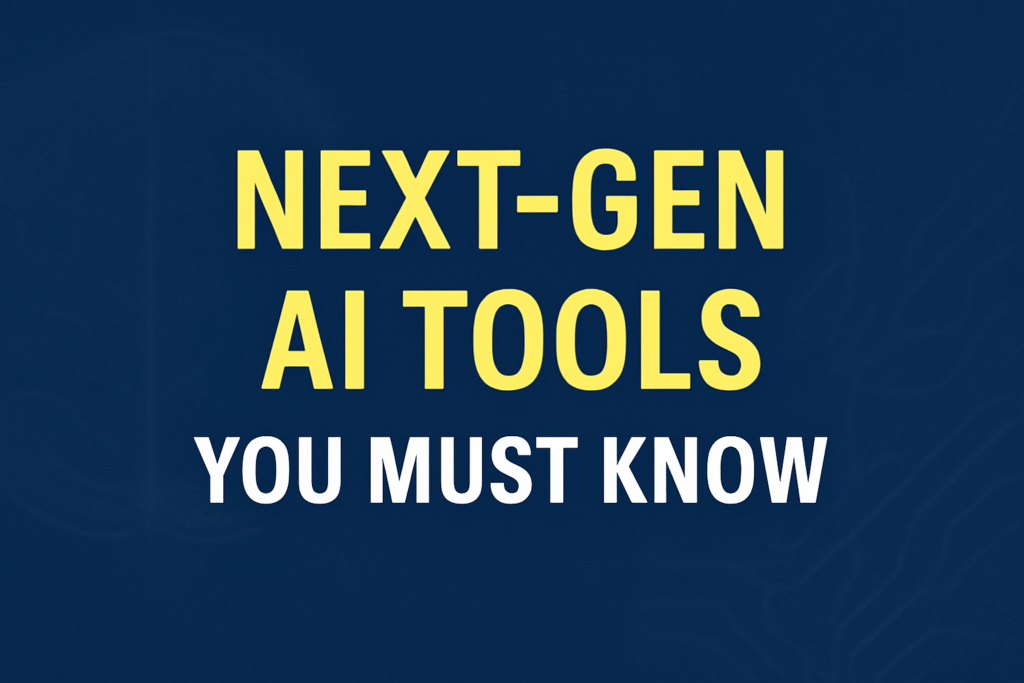It’s no exaggeration to say that we’re living through one of the most transformative moments in the history of technology. Artificial Intelligence has evolved from a buzzword into a daily reality, woven into everything from the apps we use to how we work, learn, and communicate. But what’s truly remarkable is what’s coming next.
We’re not just talking about faster chatbots or flashier algorithms. The next generation of AI tools is about meaningful, human-centered advancement—tools that help us dream bigger, work smarter, and connect more deeply. These aren’t science fiction anymore. They’re real, tangible, and closer than most people realize.
Let’s take a deep dive into some of the most promising AI tools on the horizon, and more importantly, why they matter to you and me.
Sora by OpenAI: Turning Imagination Into Moving Images
In a world driven by video—TikTok, YouTube, Instagram, online courses, and more—there’s a growing hunger for visual storytelling. But for most people, video production still feels out of reach. It’s time-consuming, expensive, and requires a steep learning curve.
Enter Sora, OpenAI’s groundbreaking video generation tool.
What makes Sora extraordinary is its simplicity: you describe a scene in words—like “a child chasing fireflies through a summer field at dusk”—and within moments, it renders a realistic video that brings your idea to life.
This has enormous implications. Storytellers, educators, marketers, and creators no longer need advanced editing software or a camera crew to express a vision. Small businesses can produce engaging ads. Non-profits can craft emotional narratives. Teachers can visualize abstract concepts. With Sora, video becomes as easy to create as writing a paragraph.
And the potential for accessibility and inclusivity is huge. People who never had access to professional tools now have the chance to communicate through motion, mood, and color. It’s not just technology—it’s liberation through creativity.
Smarter AI Agents: Teammates, Not Just Tools
We’ve all used digital assistants—Siri, Alexa, Google Assistant. They’re handy for reminders or quick searches, but let’s be honest: they’re limited. They don’t really understand us. They don’t adapt or think ahead. That’s about to change.
The upcoming wave of AI agents is different. These aren’t just tools you command. They’re designed to work with you—more like a colleague than a calculator.
Imagine an AI agent that knows how you work. It remembers your writing style, understands your goals, prioritizes your tasks, and even suggests what you should do next based on your upcoming deadlines. It can research topics, draft proposals, analyze documents, manage your calendar, and book your travel—all without needing step-by-step instructions.
This is especially game-changing for freelancers, entrepreneurs, and small teams who juggle dozens of roles at once. With the right AI agent, you’re not just more productive—you’re less stressed, more focused, and better supported.
And in the long term, these tools might help reduce burnout by letting people concentrate on what humans do best: strategy, empathy, innovation, and connection.
Healthcare AI: Merging Intelligence with Compassion
Healthcare is one of the most sensitive and high-stakes areas of human life. And it’s also one of the most complex—millions of data points, difficult decisions, and time-critical diagnoses. AI has already started assisting doctors with things like reading scans and predicting outcomes. But what’s coming next is even more profound.
Soon, we’ll see AI-powered diagnostic tools that help spot rare diseases by analyzing patterns across huge datasets—faster and more accurately than any human alone. This could lead to earlier interventions, better outcomes, and potentially even saving lives.
But even more touching is the development of empathetic AI tools for emotional and long-term care. Imagine a senior citizen living alone who has a compassionate AI companion to talk with, check in on medication, or simply offer conversation on a lonely afternoon. Or a mental health support AI trained to listen, reflect, and provide comforting responses when someone’s feeling anxious or overwhelmed.
We often talk about AI being intelligent. But in healthcare, it’s just as important for it to be kind.
AI for Everyday Creativity: Everyone Gets to Be an Artist
Creativity is one of the most deeply human traits we have. Whether it’s painting, music, storytelling, or design—creating something from nothing is incredibly powerful. But until now, expressing creative ideas often required years of training or expensive tools.
That barrier is rapidly disappearing.
AI tools like Adobe Firefly, RunwayML, and Google’s MusicLM are making it possible for anyone to create high-quality visual art, music, and animations just by describing what they imagine.
Want to design a logo for your new project? Just type a few words. Need background music for your podcast? Hum a melody, and the AI fills in the instruments. Teaching kids about the solar system? Let them create an interactive animation with nothing more than a voice command.
The point isn’t to replace artists. It’s to empower more people to explore their creative potential. Not everyone wants to be a professional, but everyone should have the tools to express themselves—and now they can.
Ethical and Transparent AI: Keeping the Future Honest
As powerful as AI is becoming, there’s a growing need for transparency, safety, and ethics. The systems we build will shape the way we live—so they must reflect fairness, accountability, and trust.
That’s why one of the most important areas of upcoming AI development involves tools that explain and audit AI decisions. Why did a system reject your job application? Why did it recommend one medical treatment over another? We need answers—and these tools are being built to give them.
There’s also progress being made in context-aware moderation tools that can tell the difference between satire, harmful content, or cultural nuance—making platforms safer without being heavy-handed.
These developments may not be flashy, but they’re absolutely critical. Because if AI is going to help us make decisions in education, hiring, law, and healthcare, it must be accountable to humans. Always.
The Big Picture: It’s Still About People
It’s easy to get swept up in the technology—the speed, the features, the endless “wow” moments. But here’s the truth: the most exciting thing about upcoming AI tools isn’t the tools themselves. It’s what they allow people to do.
AI is giving us time back. It’s amplifying creativity. It’s offering help in places we didn’t have help before. Whether you’re a student, a caregiver, a startup founder, a teacher, or an artist, AI is becoming less of a barrier—and more of a bridge.
This isn’t about humans versus machines. It’s about humans working with machines to do more, dream bigger, and live better.
AI isn’t the future. People, empowered by AI, are.


